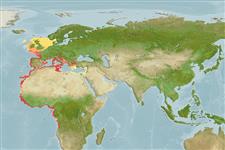Actinopterygii (ray-finned fishes) >
Perciformes (Perch-likes) >
Scombridae (Mackerels, tunas, bonitos) > Scombrinae
Etymology: Orcynopsis: Greek, orkynos, -ou = a kind of tunna + Greek, opsis = similar to (Ref. 45335).
Environment / Climate / Range
Ecology
Marine; brackish; pelagic-neritic; oceanodromous (Ref. 51243). Subtropical, preferred 19°C (Ref. 107945); 60°N - 13°S, 18°W - 36°E
Eastern Atlantic: Oslo, Norway south to Dakar, Senegal but the range is centered in the southern Mediterranean Sea. Not known from Madeira, the Canary Islands or Cape Verde.
Length at first maturity / Size / Weight / Age
Maturity: Lm ?, range 70 - 80 cm
Max length : 130 cm FL male/unsexed; (Ref. 168); common length : 90.0 cm FL male/unsexed; (Ref. 168); max. published weight: 13.1 kg (Ref. 168)
Dorsal
spines
(total): 12 - 14;
Dorsal
soft rays
(total): 12-15;
Anal
soft rays: 14 - 16. Mouth rather large, upper jaw reaching to hind margin of eye. Laminae of olfactory rosette 25 to 28. Interpelvic process small and bifid. Body naked behind the well developed corselet. Swim bladder absent. Vertebrae 17 or 18 precaudal plus 19 to 21 caudal, total 37 to 39. Anterior three quarters of first dorsal fin black.
Adults are neritic, confined primarily to temperate waters, but juveniles may be encountered in waters of up to 30°C. Form small schools at the surface so that the first dorsal fin stands out of the water like that of sharks, also frequently associated with birds. Feed on small fishes, especially sardines, anchovies, jacks, mackerel, bogue and others. Eggs and larvae are pelagic (Ref. 6769). Marketed canned or frozen.
A female weighing 5 or 6 kg may carry some 500 to 600,000 eggs which are spawned in portions.
Collette, B.B. and C.E. Nauen, 1983. FAO Species Catalogue. Vol. 2. Scombrids of the world. An annotated and illustrated catalogue of tunas, mackerels, bonitos and related species known to date. Rome: FAO. FAO Fish. Synop. 125(2):137 p. (Ref. 168)
IUCN Red List Status (Ref. 115185)
CITES (Ref. 94142)
Not Evaluated
Threat to humans
Harmless
Human uses
Fisheries: minor commercial; gamefish: yes
More information
ReferencesAquacultureAquaculture profileStrainsGeneticsAllele frequenciesHeritabilityDiseasesProcessingMass conversion
Tools
Special reports
Download XML
Internet sources
